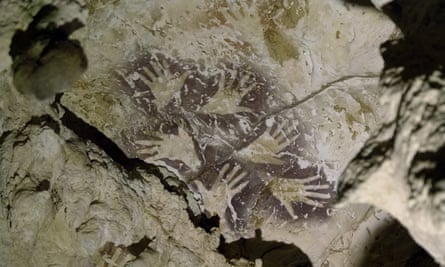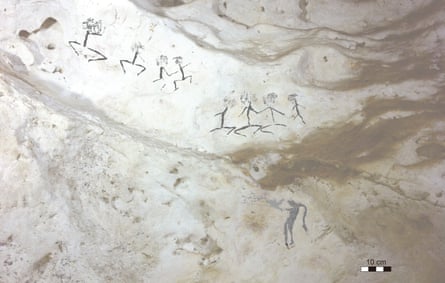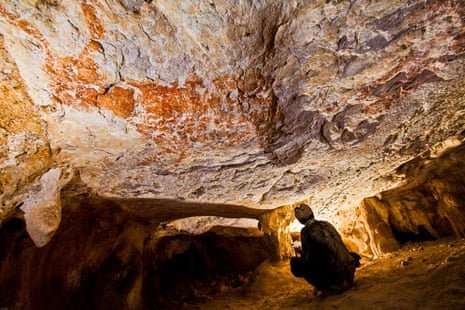A patchy, weathered painting of a beast daubed on the wall of a limestone cave in Borneo may be the oldest known example of figurative rock art, say researchers who dated the work.
Faded and fractured, the reddish-orange image depicts a plump but slender-legged animal, probably a species of wild cattle that still lives on the island, or simply dinner in the eyes of the artist, if one streak of ochre that resembles a spear protruding from its flank is any guide.
The animal is one of a trio of large creatures that adorn a wall in the Lubang Jeriji Saléh cave in the East Kalimantan province of Indonesian Borneo. The region’s rock art, which amounts to thousands of paintings in limestone caves, has been studied since 1994 when the images were first spotted by the French explorer Luc-Henri Fage.

“It is the oldest figurative cave painting in the world,” said Maxime Aubert, an archaeologist and geochemist at Griffith University in Queensland, Australia. “It’s amazing to see that. It’s an intimate window into the past.”
Above and between the three beasts are hand stencils, the familiar cave art calling cards of our ancient ancestors. The ghostly markings, which appear singularly or in groups, are made by spraying ochre paint from the mouth over a hand pressed on to the rock.
The scientists came up with ages for the paintings by dating popcorn-like calcite crusts that often dot the walls of limestone caves. The crusts form when rainwater seeps through the walls. Those underneath a painting give a maximum age for the artwork, while those on top provide a minimum age.
Aubert’s team found calcite crusts near the rear of the painted animal and used a technique called uranium series analysis to date them to at least 40,000 years old. If the measurement is accurate the Borneo paintings may be 4,500 years older than depictions of animals that adorn cave walls on the neighbouring island of Sulawesi.

But there is room for doubt. Writing in the journal Nature, the researchers concede that the crusts they analysed had formed on top of a heavily weathered part of the animal painting and that pigment analyses could not distinguish the underlying paint from that of a nearby mulberry-coloured hand stencil.
Cave art in East Kalimantan can be grouped into three distinct phases. The oldest includes the reddish-orange hand stencils and animal paintings that mostly appear to depict Bornean banteng, the wild cattle still found on the island. The next phase consists of younger hand stencils, intricate motifs and symbols, and depictions of elegant, thread-like people, some wearing elaborate headdresses, some apparently dancing, painted in dark purple or mulberry on the cave walls. In the final phase are more recent paintings of people, boats and geometric designs, all rendered in black.

Based on dates gleaned from calcite crusts in the Lubang Jeriji Saléh cave and others nearby, Aubert’s team has drawn up a tentative timeline for the progression of art in the region. They believe that rock art, which at first focused on large animal paintings, began between 40,000 and 52,000 years ago and lasted until 20,000 years ago when the second phase began. “At that time, humans start depicting the human world,” said Aubert. Whether the shift was part of the natural evolution of art, or came with the arrival of another wave of humans, no-one knows. The final phase of rock art may have began as recently as 4,000 years ago.
The work suggests that figurative art may have emerged in south-east Asia and Europe at about the same time, and remained in step when it shifted from depicting animals to the human world. At Chauvet cave in the Ardeche region of France, the walls are covered with charcoal masterpieces of horses and rhinos that are at least 30,000 years old. Rock art itself goes back much further, with Neanderthals decorating cave walls in Spain long before modern humans reached Europe. Abstract drawing began earlier still: in September, researchers published details of a 73,000-year-old lump of rock bearing an ochre criss-cross design that was uncovered in a cave in South Africa.

Paul Pettitt, professor of palaeolithic archaeology at Durham University, said that “at face value” the results point to a similar pattern for the development of art at two extremes of Eurasia more than 40,000 years ago.
But he is cautious about the dating in the latest study. “Sadly, this work says more about academic competition and the scramble for early dates than it does the emergence of art,” he said. “I welcome the impressive discovery and documentation of a major early art region, but I have considerable reservations about the pertinence of the dated samples to the art beneath. It is not made clear that the oldest minimum ages are clearly and unambiguously related to the figurative art.”









